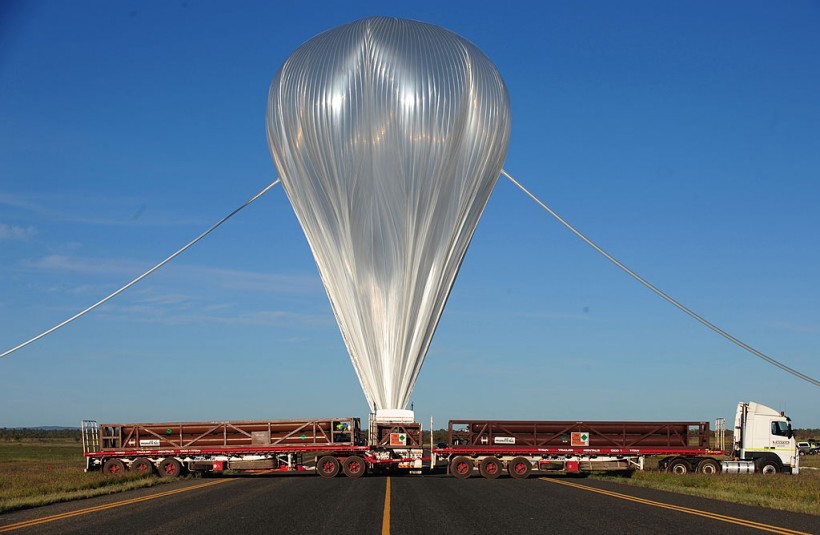In recent weeks, a large balloon has been observed encircling the Southern Hemisphere in the upper atmosphere, leading to concerns that it could be a surveillance balloon similar to the unidentified aerial object shot down over North America earlier this year.
However, NASA said that this massive floating object is its latest telescope known as the Super Pressure Balloon Imaging Telescope (SuperBIT). Instead of engaging in covert activities, the telescope is focused on studying the cosmos above, particularly in the quest to unravel the mysteries of dark matter.

This photo taken on April 16, 2010 shows a giant NASA science balloon being inflated at the launch site near Alice Springs.
NASA's SuperBIT Oversees the Cosmos To Gather Information About Dark Matter
Launched on April 16 from Wānaka, New Zealand, the SuperBIT telescope has completed multiple orbits around the Southern Hemisphere, marking the longest continuous flight for a balloon-borne telescope.
Photographer Erwin Enrique Sandoval captured a clear image of the enormous balloon over southern Chile on May 6. Situated at an altitude that surpasses 99.2% of Earth's atmosphere, SuperBIT enjoys an unobstructed view of the stars and can operate day and night, according to the SuperBIT website.
SuperBIT's main objective is to investigate the dark matter by capturing detailed images of galaxies, particularly focusing on gravitational lensing effects that may reveal insights about this elusive substance.
Live Science cited a recent study that highlighted the significance of analyzing peculiarly distorted "Einstein rings" to uncover the true nature of dark matter. Astronomers believe that the data gathered by SuperBIT rivals the quality of observations made by the Hubble Space Telescope, leading to the capture of stunning images of distant galaxies.
Beyond astronomy, giant balloons like SuperBIT, hold potential for various applications. Space tourism company Space Perspective has unveiled plans to employ similar balloons to transport civilians to the edge of space.
NASA's Scientific Balloon Program Office chief Debbie Fairbrother said that the SuperBIT balloon is expected to continue its revolutions around the hemisphere in the coming weeks, presenting more opportunities for observers and astronomy enthusiasts to witness its presence, according to Debbie Fairbrother, chief of NASA's Scientific Balloon Program Office.
READ ALSO: Chinese Spy Balloon Suspected to Hold Bioweapons; US Shoots It Down
NASA Releases SuperBIT's First Research Images
During its recent flight, NASA wrote in its blog that the SuperBIT telescope captured its first research images of the Tarantula Nebula and Antennae Galaxies. SuperBIT, which was floating at an altitude of 108,000 feet above the Earth's surface on a balloon-borne platform, enabled scientists to examine these scientific goals from a near-space environment.
Utilizing a balloon-based telescope offers cost advantages compared to space telescopes since it eliminates the need for launching a large telescope via a rocket. The super pressure balloon used by SuperBIT can travel around the globe for up to 100 days, enabling the collection of valuable scientific data. Additionally, the balloon operates above a significant portion of Earth's atmosphere, making it suitable for various astronomical observations.
SuperBIT specializes in obtaining photographs of galaxies in the visible-to-near ultraviolet light spectrum, which the Hubble Space Telescope also covers but with a larger field of vision. The mission's objective is to map dark matter around galaxy clusters by studying the gravitational lensing effect caused by these massive objects, referred to as "weak gravitational lensing."
The Tarantula Nebula, located in the Large Magellanic Cloud approximately 161,000 light-years away, is a vast region of ionized hydrogen gas where turbulence and dense clouds of gas and dust swirl amidst the formation of new stars. The Hubble Space Telescope and the James Webb Space Telescope have previously captured images of the Tarantula Nebula.
RELATED ARTICLE: SCoPEx Balloon Test Flight Aimed at Cooling Earth Canceled, Likely to Launch on 2022
Check out more news and information on Tech and Innovation in Science Times.














